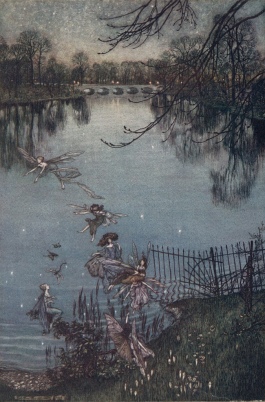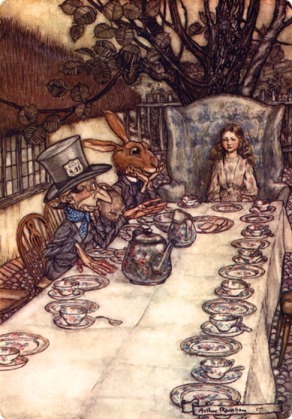 For my final paper I am focusing, unsurprisingly, on children’s book illustration. More specifically, I am planning to write about Arthur Rackham (1867-1939), a prolific early-twentieth century British illustrator. While Rackham illustrated a vast number of books, I intend to focus on his illustrations for Alice in Wonderland and Peter Pan in Kensington Gardens and examine how these illustrations are representative of major themes in children’s book illustration during the Golden Age. (I realize that this is still somewhat vague, most of my research so far has been limited to biographical information while I wait for a couple of books on the history of children’s book illustration to arrive.)
For my final paper I am focusing, unsurprisingly, on children’s book illustration. More specifically, I am planning to write about Arthur Rackham (1867-1939), a prolific early-twentieth century British illustrator. While Rackham illustrated a vast number of books, I intend to focus on his illustrations for Alice in Wonderland and Peter Pan in Kensington Gardens and examine how these illustrations are representative of major themes in children’s book illustration during the Golden Age. (I realize that this is still somewhat vague, most of my research so far has been limited to biographical information while I wait for a couple of books on the history of children’s book illustration to arrive.)
Rackham was commissioned to illustrate Peter Pan in Kensington Gardens in 1905, completing fifty full-page color illustrations for the text. His illustrations were praised by both Barrie and critics, and the book was the most popular gift-book for Christmas in 1906. Rackham’s Alice in Wonderland, published in time for Christmas in 1907 after the book’s original copyright expired, was one of the first re-illustrated versions to be released since the publication of the original with John Tenniel’s iconic illustrations. Interestingly, several other re-illustrated versions were released at the same time, but Rackham’s was the only to endure.
 One specific area that interests me is the production and reception of deluxe limited editions of illustrated books during this period. Many of Rackham’s books were published in these sorts of editions and were extremely popular as Christmas gifts, as I mentioned in the previous paragraph. However, I am finding in my research that such lavish editions, while popular, also attracted criticism when it came to children’s books. For example, the illustrations for Peter Pan were printed, as was customary, on thick paper and protected by tissue fly-leaves (some of the books that we looked at on our visit to the Baldwin were printed in this manner). Critics attacked this practice, however, claiming that such fine books were more suited for “the drawing-room rather than the nursery” (Hudson 66). They argue that in creating such luxurious editions, the books were turned into art objects more easily admired by adults than enjoyed and used by children. I plan to try and locate the full original responses by critics that are cited in the books I have read, and I hope to further explore this debate and its implications for Rackham’s work and Golden Age children’s illustration.
One specific area that interests me is the production and reception of deluxe limited editions of illustrated books during this period. Many of Rackham’s books were published in these sorts of editions and were extremely popular as Christmas gifts, as I mentioned in the previous paragraph. However, I am finding in my research that such lavish editions, while popular, also attracted criticism when it came to children’s books. For example, the illustrations for Peter Pan were printed, as was customary, on thick paper and protected by tissue fly-leaves (some of the books that we looked at on our visit to the Baldwin were printed in this manner). Critics attacked this practice, however, claiming that such fine books were more suited for “the drawing-room rather than the nursery” (Hudson 66). They argue that in creating such luxurious editions, the books were turned into art objects more easily admired by adults than enjoyed and used by children. I plan to try and locate the full original responses by critics that are cited in the books I have read, and I hope to further explore this debate and its implications for Rackham’s work and Golden Age children’s illustration.
A gallery of Rackham’s Peter Pan illustrations can be found here.
A Rackham edition of Alice in Wonderland can be viewed here.
Sources:
Hamilton, James. Arthur Rackham: A Life with Illustration. London: Pavilion, 1990.
Hudson, Derek. Arthur Rackham: His Life and Work. New York: Charles Scribner’s Sons, 1960.










